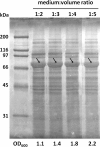High level expression and facile purification of recombinant silk-elastin-like polymers in auto induction shake flask cultures
- PMID: 23384239
- PMCID: PMC3599559
- DOI: 10.1186/2191-0855-3-11
High level expression and facile purification of recombinant silk-elastin-like polymers in auto induction shake flask cultures
Abstract
Silk-elastin-like polymers (SELPs) are protein-based polymers composed of repetitive amino acid sequence motifs found in silk fibroin (GAGAGS) and mammalian elastin (VPGVG). These polymers are of much interest, both from a fundamental and applied point of view, finding potential application in biomedicine, nanotechnology and as materials. The successful employment of such polymers in such diverse fields, however, requires the ready availability of a variety of different forms with novel enhanced properties and which can be simply prepared in large quantities on an industrial scale. In an attempt to create new polymer designs with improved properties and applicability, we have developed four novel SELPs wherein the elastomer forming sequence poly(VPGVG) is replaced with a plastic-like forming sequence, poly(VPAVG), and combined in varying proportions with the silk motif. Furthermore, we optimised a simplified production procedure for these, making use of an autoinduction medium to reduce process intervention and with the production level obtained being 6-fold higher than previously reported for other SELPs, with volumetric productivities above 150 mg/L. Finally, we took advantage of the known enhanced stability of these polymers in developing an abridged, non-chromatographic downstream processing and purification protocol. A simple acid treatment allowed for cell disruption and the obtention of relative pure SELP in one-step, with ammonium sulphate precipitation being subsequently used to enable improved purity. These simplified production and purification procedures improve process efficiency and reduce costs in the preparation of these novel polymers and enhances their potential for application.
Figures









Similar articles
-
Silk-elastin-like protein biomaterials for the controlled delivery of therapeutics.Expert Opin Drug Deliv. 2015 May;12(5):779-91. doi: 10.1517/17425247.2015.989830. Epub 2014 Dec 5. Expert Opin Drug Deliv. 2015. PMID: 25476201 Free PMC article. Review.
-
Batch production of a silk-elastin-like protein in E. coli BL21(DE3): key parameters for optimisation.Microb Cell Fact. 2013 Feb 27;12:21. doi: 10.1186/1475-2859-12-21. Microb Cell Fact. 2013. PMID: 23446293 Free PMC article.
-
Tunable self-assembly of genetically engineered silk--elastin-like protein polymers.Biomacromolecules. 2011 Nov 14;12(11):3844-50. doi: 10.1021/bm201165h. Epub 2011 Sep 30. Biomacromolecules. 2011. PMID: 21955178 Free PMC article.
-
Modeling and Experiment Reveal Structure and Nanomechanics across the Inverse Temperature Transition in B. mori Silk-Elastin-like Protein Polymers.ACS Biomater Sci Eng. 2017 Nov 13;3(11):2889-2899. doi: 10.1021/acsbiomaterials.6b00688. Epub 2017 Apr 18. ACS Biomater Sci Eng. 2017. PMID: 33418710 Free PMC article.
-
Silk-elastinlike protein polymers for matrix-mediated cancer gene therapy.Adv Drug Deliv Rev. 2010 Dec 30;62(15):1509-23. doi: 10.1016/j.addr.2010.04.006. Epub 2010 Apr 27. Adv Drug Deliv Rev. 2010. PMID: 20430059 Review.
Cited by
-
Biosynthesis and Characterization of Recombinant Silk-Like Polypeptides Derived from the Heavy Chain of Silk Fibrion.Polymers (Basel). 2017 Dec 3;9(12):669. doi: 10.3390/polym9120669. Polymers (Basel). 2017. PMID: 30965969 Free PMC article.
-
Elastin-like Recombinamers as a Biotechnological Platform for the Development of Cytokine-Functionalized Materials.ACS Omega. 2024 Nov 12;9(47):46733-46742. doi: 10.1021/acsomega.3c09325. eCollection 2024 Nov 26. ACS Omega. 2024. PMID: 39619521 Free PMC article.
-
Alternative Heterologous Expression of L-Arabinose Isomerase from Enterococcus faecium DBFIQ E36 By Residual Whey Lactose Induction.Mol Biotechnol. 2021 Apr;63(4):289-304. doi: 10.1007/s12033-021-00301-2. Epub 2021 Jan 27. Mol Biotechnol. 2021. PMID: 33502742
-
Silk-elastin-like protein biomaterials for the controlled delivery of therapeutics.Expert Opin Drug Deliv. 2015 May;12(5):779-91. doi: 10.1517/17425247.2015.989830. Epub 2014 Dec 5. Expert Opin Drug Deliv. 2015. PMID: 25476201 Free PMC article. Review.
-
Batch production of a silk-elastin-like protein in E. coli BL21(DE3): key parameters for optimisation.Microb Cell Fact. 2013 Feb 27;12:21. doi: 10.1186/1475-2859-12-21. Microb Cell Fact. 2013. PMID: 23446293 Free PMC article.
References
-
- Cappello J, Crissman JW, Crissman M, Ferrari FA, Textor G, Wallis O, Whitledge JR, Zhou X, Burman D, Aukerman L, Stedronsky ER. In-situ self-assembling protein polymer gel systems for administration, delivery, and release of drugs. J Control Release. 1998;3(1–3):105–117. - PubMed
LinkOut - more resources
Full Text Sources
Other Literature Sources
Miscellaneous

